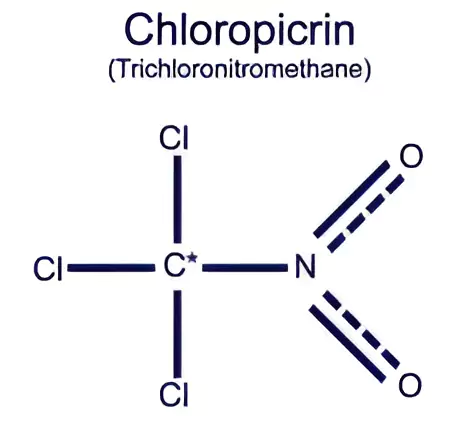Context
The U.S. State Department in its factsheet accused Russia of having used chemical weapons against Ukrainian forces which is a gross violation of the Chemical Weapons Convention.
US accuses Russia of using ‘chemical weapon’ in Ukraine
- Russia used chemical agent chloropicrin in Ukraine along with the “riot control agents (tear gas) as a method of warfare in Ukraine.
- Sanctions: USA announced fresh sanctions against Moscow’s military and industrial capabilities which targets nearly 300 entities in Russia, China, and other countries
What is Chloropicrin?

- About: Chloropicrin is a C-nitro compound that is nitromethane in which all three hydrogens are replaced by chlorines.
- It is a synthetic C-nitro, one-carbon, and organochlorine compound that is a strong lachrymator (tears-inducing agent, popular examples: pepper spray, and bromoacetone).
- Common names: Nitrochloroform, Dolochlor,Picfume
- Appearance: Colorless to faintly yellow oily liquid.
- Composed of: It involves a chemical reaction between sodium hypochlorite ( bleach) and nitromethane (a common industrial solvent).
- It can also be made by combining chloroform with nitric acid, which yields chloropicrin and water.
Enroll now for UPSC Online Course
- Application:
- Agriculture: It is used in agriculture as a soil fumigant particularly for strawberry crops.
- Antimicrobial agent: It is employed as a herbicide and nematicide and has a role as a fumigant insecticide and an antifungal agrochemical.
- Chemical warfare agent: Chloropicrin is an irritant with characteristics of a tear gas having an intensely irritating odor, thus used as a riot control agent.
- As a weapon of warfare: It was first used as a poison gas in the First World War, by both the Allied and the Central Powers and was stockpiled during World War II.
- It induces vomiting, which prompts soldiers to remove their masks, when they would inhale more of the gas, or other gaseous agents dispersed in the air.
- Exposure: Chloropicrin can be absorbed systemically through inhalation, ingestion, and the skin. It is a severe irritant, and can cause immediate, severe inflammation of the eyes, nose and throat, and significant injuries to the upper and lower respiratory tract.
- It is also known to be highly toxic and carcinogenic.
Chemical Weapons Convention (CWC)
- Entered into force: On 29 April 1997
- About: It is the world’s first multilateral disarmament agreement to provide for the elimination of an entire category of weapons of mass destruction within a fixed time frame.
- Membership: 193 States Parties to the Convention
- Implementing Organ: The Convention led to the birth of an international chemical weapons disarmament regime headed by the Organisation for the Prohibition of Chemical Weapons (OPCW).
- Mandate:
- To end the development, production, stockpiling, transfer and use of chemical weapons
- To prevent their re-emergence
- To ensure the elimination of existing stocks of such weapons
- To make the world safe from the threat of chemical warfare.
- Recognition: The 2013 Nobel Prize for Peace was awarded to the Organisation for the Prohibition of Chemical Weapons for its extensive efforts to eliminate chemical weapons.
|
Also Read: North Korea’s Biological Weapons Programme
![]() 7 May 2024
7 May 2024
